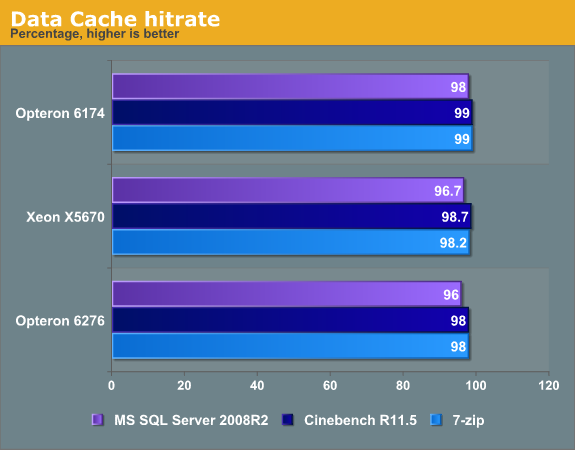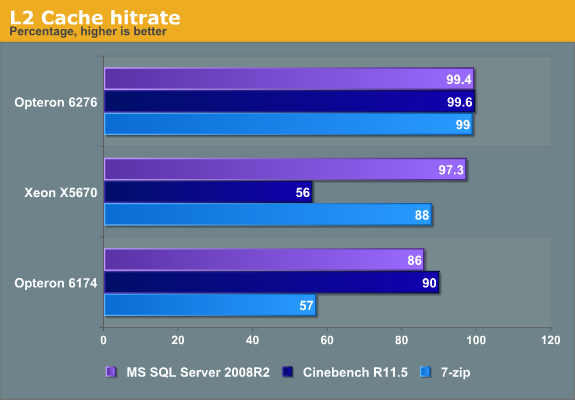The Bulldozer Aftermath: Delving Even Deeper
by Johan De Gelas on May 30, 2012 1:15 AM ESTCaching Analysis
It does not take us long to find a suspect for the lower single-threaded performance of the CMT enabled module: the instruction cache.

The instructions of Cinebench and 7-Zip fit almost perfectly in the instruction cache, but that cannot be said about our MS SQL Server SQL statements. The 8-way 32KB Instruction caches of the latest Intel CPUs are clearly not large enough and shed some light on why the Opteron 6174 performed so well in this benchmark. The older AMD CPU has up to 40% fewer instruction cache misses.
The 2-way 64KB instruction cache was clearly not the optimal choice for caching two threads: the hit rate goes from an excellent 97% down to a mediocre 95% once we enable the second integer thread. It will take some engineering, but increasing the associativity of the L1 instruction cache seems necessary to make sure that the two CMT threads do not hinder each other. Let's move on to the data cache.

Reducing the data cache from 64KB to 16KB was probably necessary in order to keep the die size of the module under control. (A Bulldozer module is less than 80 mm², while two Magny-Cours cores are good for 115 mm².) However this reduction comes with a price: the data cache suffers twice as many misses as before. Intel's 8-way cache does a bit better, but it is not spectacular. Now let's check out the L2 caches.

The very low L2 cache hit rates on the older Opteron and Xeon seem like a fluke but that is not the case. In the case of Cinebench, don't forget that this benchmark has an extremely low miss rate in the L1 cache, so most of the easy to cache code and data is already there. The relatively high L2 cache miss rate on the Xeon means that 44% of less than 1% misses the L2 cache--or in other words, almost nothing. The data is almost perfectly cache inside the caches and the data cache hit rate is 99.99%. Most of the L2 cache misses are a few hardly used instructions.
The same is true for the relatively bad hit rate of the Opteron 6174 L2 cache in 7-Zip. The Opteron has a higher L1 data cache hit rate than the other CPUs, so the L2 cache is less accessed. The bad L2 hit rate is not the reason for the lower performance of the older Opteron. Which brings us to the final area of analysis....










84 Comments
View All Comments
Zoomer - Thursday, May 31, 2012 - link
True. It's probably better out way back then, but synthesized, than to come out maybe next year with all their lovingly fully customized, hand placed transistors. That's if they don't go bankrupt first.wolfman3k5's probably going to call nVidia, 3dfx, ATi (then), most FPGA program design houses, etc, lazy, too.
misiu_mp - Monday, June 11, 2012 - link
A large margin of error means that you have a lot of space to make errors with little consequence.You meant of course that engineers have small margins of error in their work.
500MM - Wednesday, May 30, 2012 - link
http://images.anandtech.com/graphs/graph5057/42770...If lower was better, AMD would have one kickass CPU. The caption is wrong.
JohanAnandtech - Friday, June 1, 2012 - link
Fixed, thx!weebnuts - Wednesday, May 30, 2012 - link
The problem with all these benchmarks is that most organizations are going to be using this is Xen or Vmware uses. The idea is that with more cores, you can run more VM's especially if you are trying to implement Virtual Desktops. How do the processors compare when you are loading the server to 80-90% capacity with lots of VM's? That's a real world comparison I want to see.Iketh - Wednesday, May 30, 2012 - link
I was dying for information like this. Thank you!And as for that quote on the first page by Iketh, that guy is a genious!! :D
Aone - Thursday, May 31, 2012 - link
1) Maybe i missed something but, Should "Higher is better" be for "Data Cache hitrate", i.e. opposite to cache misses?2) And on the chart "L2 Cache hitrate", is it correct that "Opteron 6276" tag is shown on first line while "Opteron 6174" on the last line? I thought Opteron 6174 was faster in MS SQL than Opteron 6276.
mrdcook - Thursday, May 31, 2012 - link
There are a few new instructions in Bulldozer's architecture that, for certain specific computations, can make it 10X faster than Intel. For example, FMA. An FMA does a multiply and then an add as one instruction, rounding only once. Combining the multiply and the add isn't such a big deal (and in many cases can even be counter-productive), but rounding only once is very important in some cases.For example, assume you have 3 digits of accuracy and want to calculate (1.23 * 2.31 - 2.84). Without FMA, you calculate Round(1.23 * 2.31) = 2.84, then you calculate Round(2.84 - 2.84) = 0. With FMA, you calculate 1.23 * 2.31 = 2.8413, then you calculate Round(2.8413 - 2.84) = 0.0013. While that may seem contrived (it was!), the difference is significant in certain simulations and calculations.
When doing math, computers have a very specific level of accuracy -- a certain number of digits of precision. If you want your simulations to come out right, you have to take these limits into account. Learning how to account for the computer's rounding errors is a bit of a black art.
Mathematicians design algorithms in terms of matrix multiplications and dot products, and if you translate those algorithms directly into computer multiplications and additions, you tend to end up with a lot of cancellation errors like the example given above. You can hire a computer science grad student to rework your algorithm to not lose accuracy, but that is expensive and has to be done for every new algorithm. Or you can use an FMA for the dot products and the matrix multiplications (the high-accuracy dot product and matrix multiplication libraries already do this).
FMA in software is slow. Single-precision emulated FMA isn't too bad since you can use double-precision to help with the hardest bits of the emulation. The result is that you can do one fmaf in about 4X the amount of time it would take to do a single a*b+c. However, SSE2 allows you to do 4 a*b+c at a time, so emulated single-precision FMA ends up being about 15X slower than optimized SSE2 non-fused multiply-add. Double-precision is harder, taking about 10 times longer than a single a*b+c, so it ends up being 20X slower than non-fused multiply-add.
Admittedly, the target market for FMA is probably smaller than a breadbox, but those who need it really need it. And as it becomes more common, it'll only become more important. For now, since only Bulldozer has it, nobody is going to care.
BaronMatrix - Thursday, May 31, 2012 - link
There are admittedly only two viable X86 licensees in America and one of them sucks...shodanshok - Thursday, May 31, 2012 - link
Hi Johan,first of all, let me thank you for your wonderful analysis on Bulldozer architecture. I read it with great interest.
However, I think that you left out a very important thing to mention: L1/L2 cache read/write bandwidth. Especially for L2, while latency is an important thing, throughput can be an even more crucial one.
The key point is that Bulldozer has an write-through L1 cache, so all L1 writes are more or less immediately broadcasted to L2 cache. Some small writes can be effectively cached inside a write-back combining buffer called Write Combining Cache (WCC), but this cache is only 4KB in size per the entire module. So, streaming writes will immediatly fill the WCC and bring down L1 cache speed to L2 levels.
This can really hamper CPU performance. Obviously, AMD went this road for some understandable reasons, however, the WCC is really too small to cache much data and the L2 is way too slow to efficiently serve L1 write requests.
This bring us to another point: L2 cache is slow. Comparing this with the super-fast (but much smaller) L2 Intel cache, it has no hope; it is more or less at Intel's L3 level.
Here you can find my analysis of AMD Bulldozer architecture: http://www.ilsistemista.net/index.php/hardware-ana...">AMD Bulldozer analysis
Note that, while I collected and normalized data from multiple web site, I left very clear what was the original reference (so that you can easily verify my data).
Thanks.